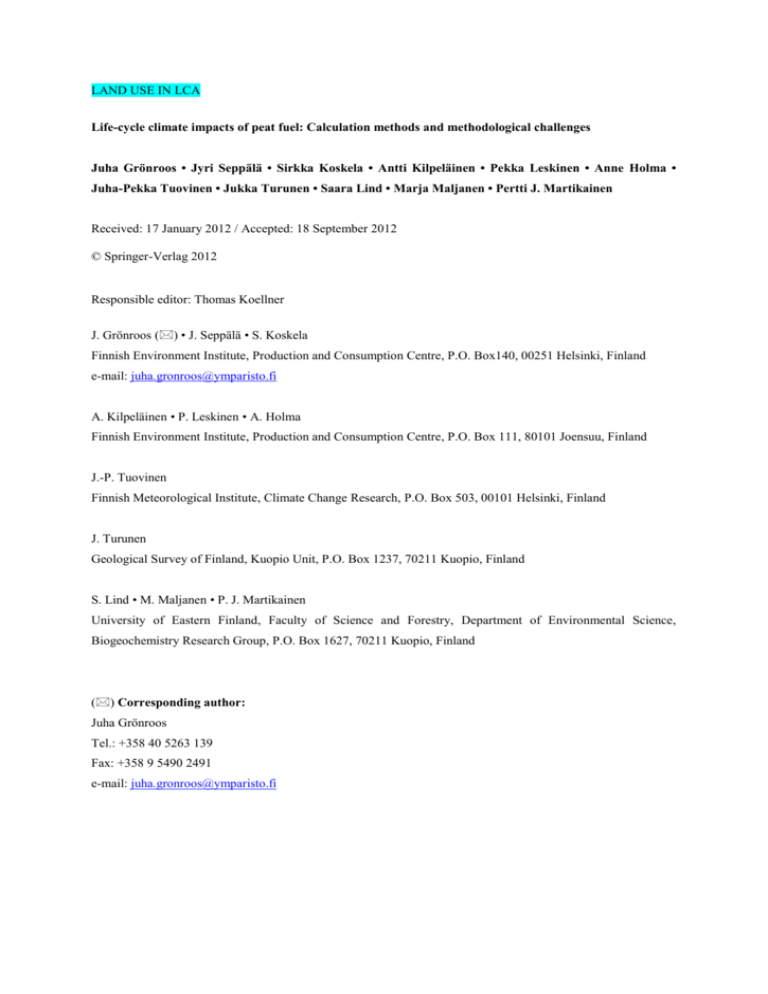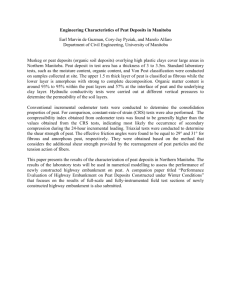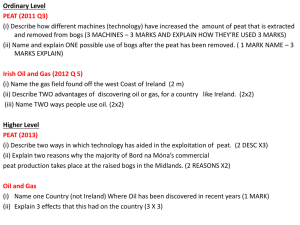LAND USE IN LCA
advertisement

LAND USE IN LCA Life-cycle climate impacts of peat fuel: Calculation methods and methodological challenges Juha Grönroos • Jyri Seppälä • Sirkka Koskela • Antti Kilpeläinen • Pekka Leskinen • Anne Holma • Juha-Pekka Tuovinen • Jukka Turunen • Saara Lind • Marja Maljanen • Pertti J. Martikainen Received: 17 January 2012 / Accepted: 18 September 2012 © Springer-Verlag 2012 Responsible editor: Thomas Koellner J. Grönroos () • J. Seppälä • S. Koskela Finnish Environment Institute, Production and Consumption Centre, P.O. Box140, 00251 Helsinki, Finland e-mail: juha.gronroos@ymparisto.fi A. Kilpeläinen • P. Leskinen • A. Holma Finnish Environment Institute, Production and Consumption Centre, P.O. Box 111, 80101 Joensuu, Finland J.-P. Tuovinen Finnish Meteorological Institute, Climate Change Research, P.O. Box 503, 00101 Helsinki, Finland J. Turunen Geological Survey of Finland, Kuopio Unit, P.O. Box 1237, 70211 Kuopio, Finland S. Lind • M. Maljanen • P. J. Martikainen University of Eastern Finland, Faculty of Science and Forestry, Department of Environmental Science, Biogeochemistry Research Group, P.O. Box 1627, 70211 Kuopio, Finland () Corresponding author: Juha Grönroos Tel.: +358 40 5263 139 Fax: +358 9 5490 2491 e-mail: juha.gronroos@ymparisto.fi Appendix 1. Data sources and the best available GHG flux parameters used in the peat fuel case study GHG fluxes of the initial stage (Table A1) The best available GHG flux values of pristine boreal fen/mire were based on Aurela et al. (2004, 2007, 2009), Saarnio et al. (2007) and von Arnold et al. (2005). For forestry-drained peatland, the best value for carbon stock change in the soil (= net soil emission) was chosen directly from estimates made in the Finnish GHG inventory (Statistics Finland 2010). In this calculation, carbon emissions due to heterotrophic soil respiration from five different groups of forestry-drained peatlands were obtained from Minkkinen et al. (2007a) and the weighted average figure based on the corresponding areas of the peatland groups was calculated. The CH4 emission values based on the study Alm et al. (2007), which refer to Minkkinen et al. (2007b), Minkkinen and Laine (2006) and Minkkinen et al. (1997). For N 2O, values were based on Maljanen et al. (2009) and Alm et al. (2007) The CO2 emission for average cultivated peatlands (1840 g CO2 m-2 a-1) was obtained from the Finnish greenhouse gas inventory (Statistics Finland 2010). The estimation is based on the measurements made by Maljanen et al. (2007) and Lohila et al. 2004. The best estimation for abandoned organic croplands (appr. 1180 g CO2 m-2 a-1) is based on the measurements made by Maljanen et al. (2007). Fluxes for CH 4 and N2O were assumed to correspond to the figures from Maljanen et al. (2007). GHG fluxes of the peat extraction phase and surrounding area of pristine mires (Table A1) The current best available CO2 flux emissions of extraction area based on Sundh et al. (2000), Alm et al. (2007), Nykänen et al. (1996) and Shurpali et al. (2008) by combining the reported emissions. The surrounding area for pristine mires was considered and its size is half of the extraction area. The emissions of the surrounding area were assumed to correspond to the emissions of production area without stockpiles. GHG emissions from working machines, peat transport and peat combustion For working machines and peat transport, the same values were used as in Kirkinen et al. (2007), based on Uppenberg et al. (2001), i.e. 1 g CO2 MJ-1, 0 g CH4 MJ-1 and 0 g N2O MJ-1. The emission factors used for combustion were based on work by Statistics Finland (2005) and Vesterinen (2003), and were 105.9 g CO2 MJ-1, 0.0085 g CH4 MJ-1 and 0.0128 g N2O MJ-1. GHG fluxes of the after-treatment phase (Table A1) For restoration, the same values as for pristine boreal fen/mire were used. For afforestation, it was assumed that forest in the afforestation phase sequesters carbon until the average value (5.5 kg C m-2) over the rotation is reached. The assumption corresponds to the assumption made by Kirkinen et al. (2007). They assumed that afforestation causes additional growth of 3.7 m3 ha-1 a-1 compared to the initial reference situation of forestry-drained peatlands in which the forest growth was assumed to be 2,5 m3 ha-1 a-1. Thus, the total growth of afforestation is about 6.2 m3 ha-1 a-1 that corresponds to average carbon sequestration (5.5 kg C m-2). The development of carbon stock in the soil of the finished peat production area due to afforestation was estimated using the Yasso07 model (Tuomi et al. 2009). For more detailed information, see Seppälä et al. (2010). CH4 and N2O fluxes of the afforestation phase are based on the study of Mäkiranta et al. (2007). Table A1 GHG fluxes in initial stage, peat extraction, restoration and afforestation phases (values used in this study). A positive value means emission to the atmosphere and a negative value uptake by the ecosystem Initial stage Pristine fen/mire Forestry-drained peatland Cultivated peatland Peat extraction After-treatment Restoration Afforestation CO2 flux (g CO2 m-2 a-1) CH4 flux (g CH4 m-2 a-1) N2O flux (g N2O m-2 a-1) -112 (-12 to -219) 141 17 (± 13) 1 (0-2) 0 0.35 (0.009-4.1) Abandoned organic croplands: 1180 Abandoned organic croplands : - 0.22 1 Abandoned organic croplands : 1.3 Croplands: 1840 Croplands: 0.1 (range -0.5 - 0.6 1) -extraction area (strip+ditch, no stockpiles): 2.25 (0.83-5.85) - surrounding area: 2.25 (0.83-5.85) Croplands: 1.5 (range 0.1 – 5.5) -extraction area (strip+ditch, no stockpiles): 0.06 (0.005-0.079) - surrounding area: 0. 06 (0.005-0.079) 17 (± 13) mean -0.05 1 min -0.09 1 max -0.03 1 0 mean 0.35 min 0.04 max 1.76 -extraction area (strip+ditch+ stockpiles): 960 - surrounding area: 629 -112 (-12 to -219) Soil emission caused by the decomposition of residual peat: Emission starts from 1000, then exponential decrease during first 85 years until 50% of the residual peat has decomposed. Thereafter slow release so that 1200 g C m-2 at the end of simulation period (280 years). C-uptake by the growing forest: Increase by an annual forest productivity: - 413 for the forestry-drained peatlands and abandoned organic croplands (during 45 years) - 716 for cultivated peatlands and pristine fens (during 45 years) C-accumulation in the soil by litter input: 0-45 years: - 297* 46-90 years: -149* 91-180 years: -59* 181-280 years: -20* 1 Negative value of CH4: oxidation of atmospheric CH4 by soil methanotrophic bacteria is exceeding the production of CH4 in soil by methanogens









